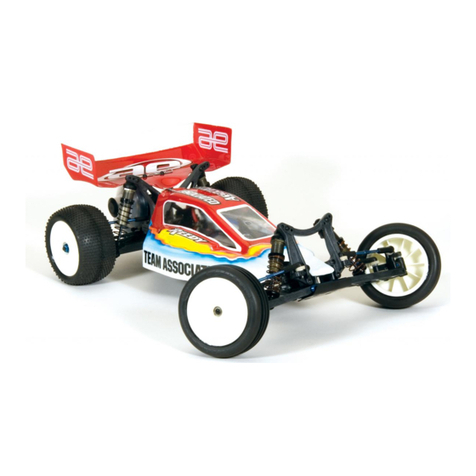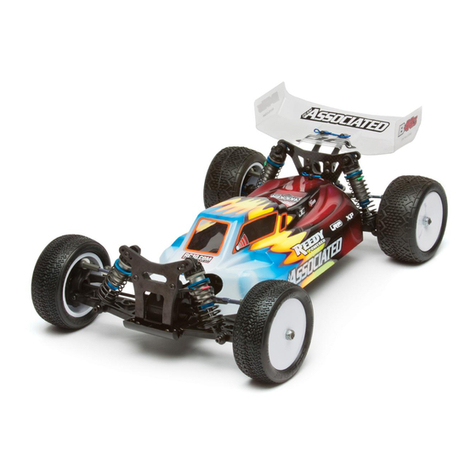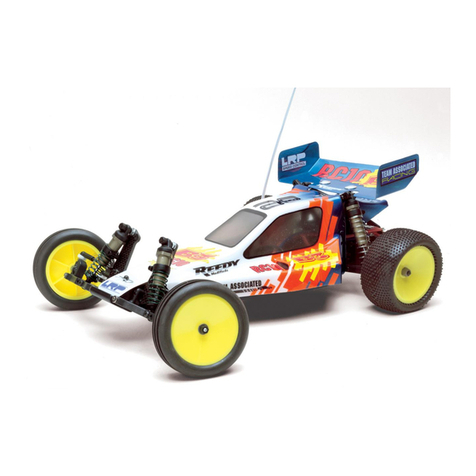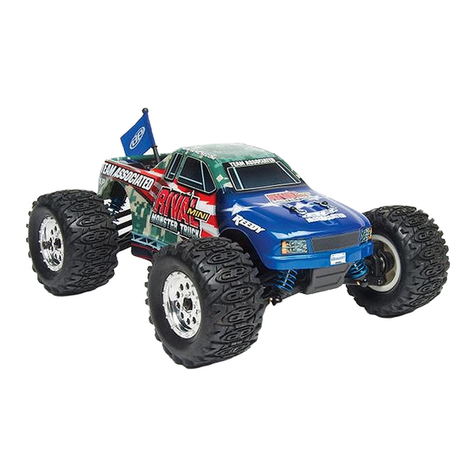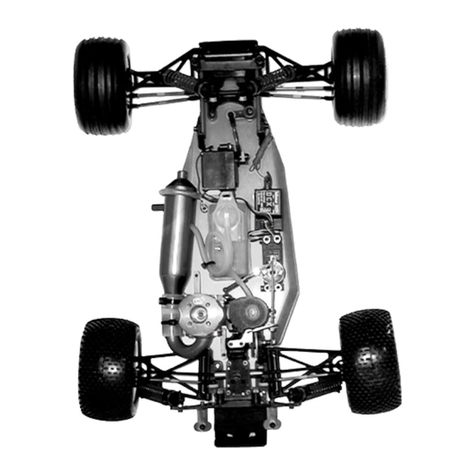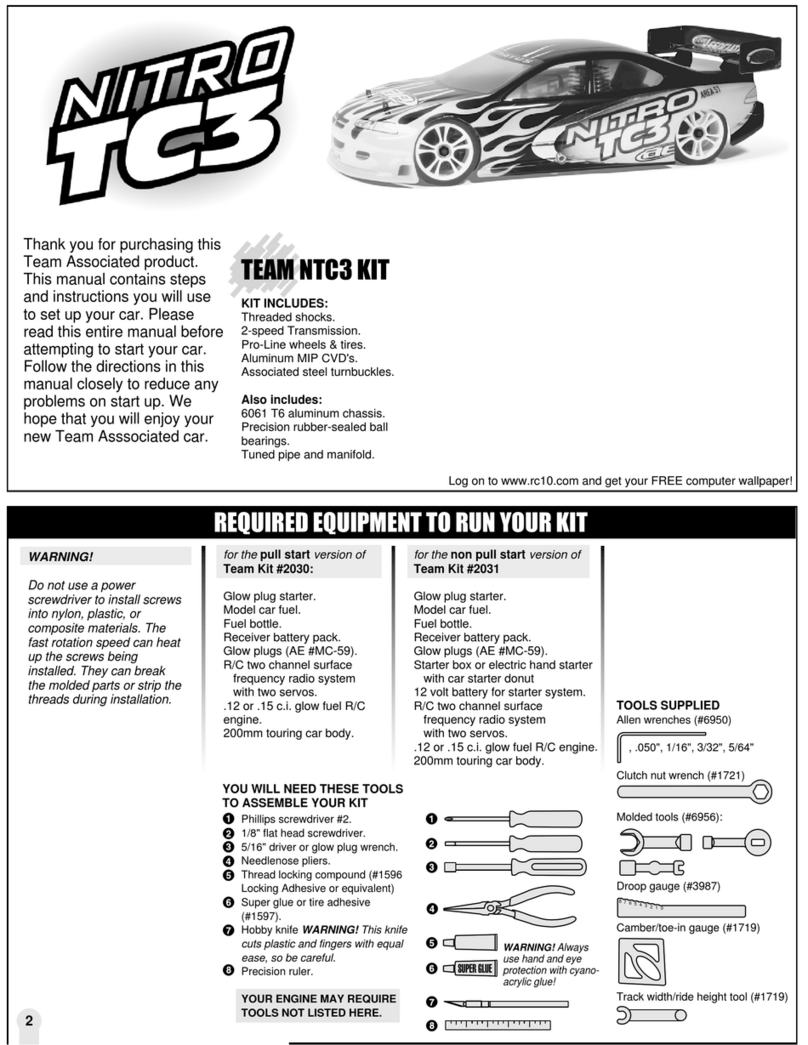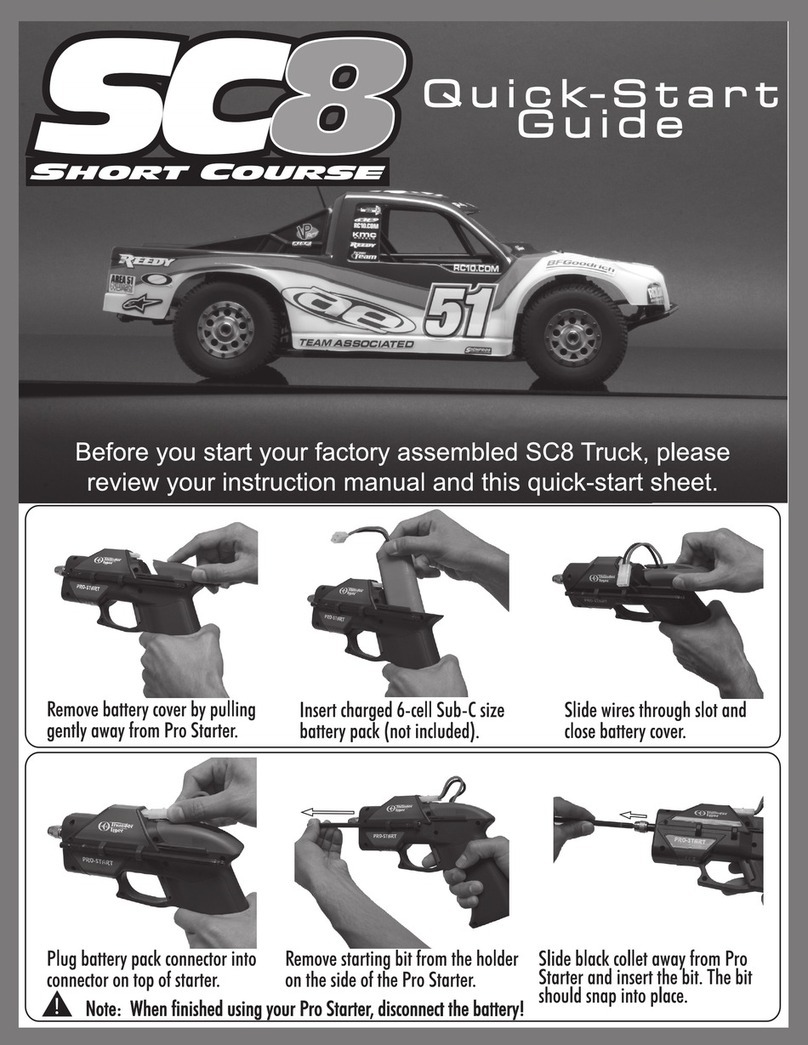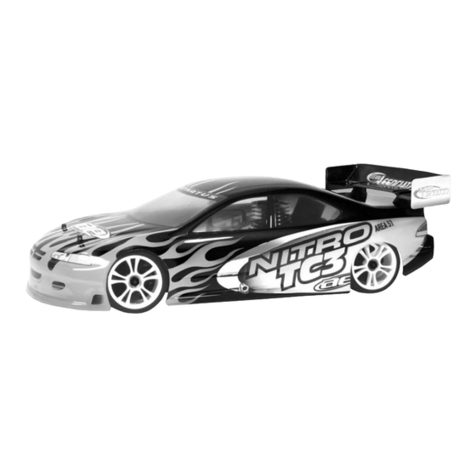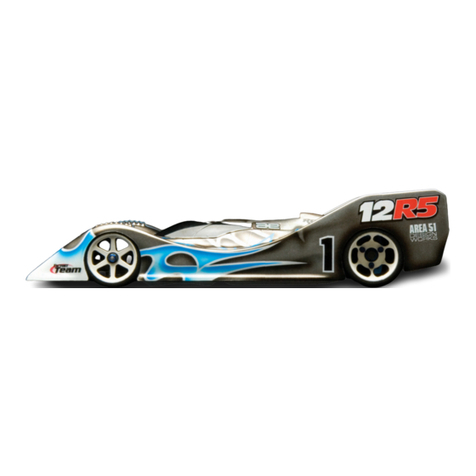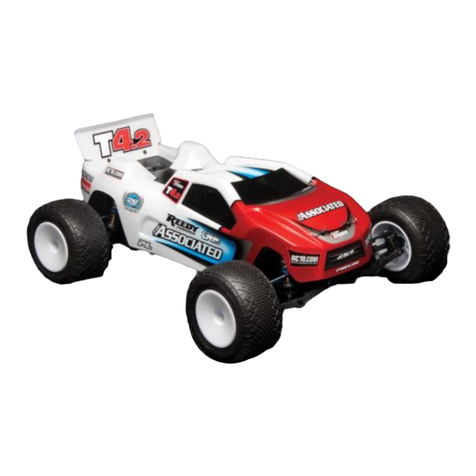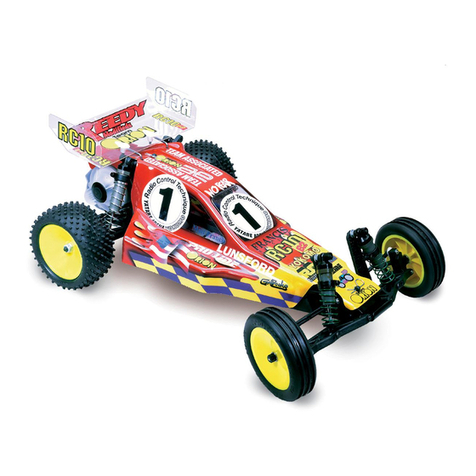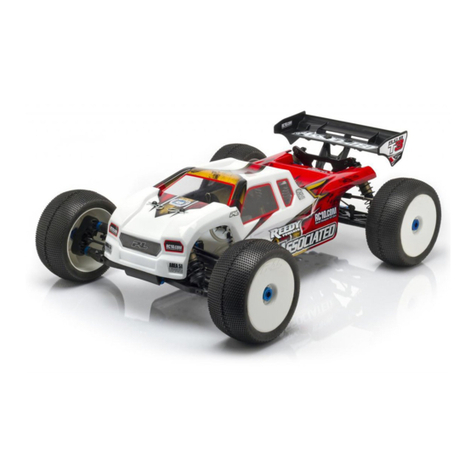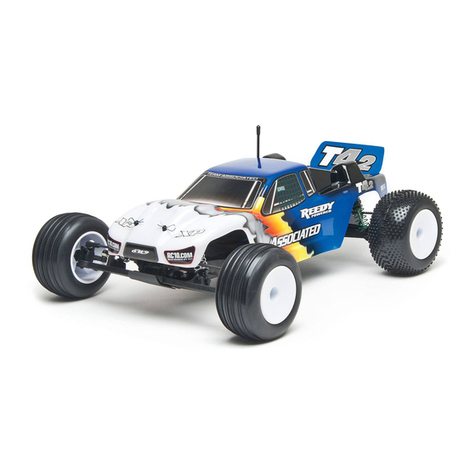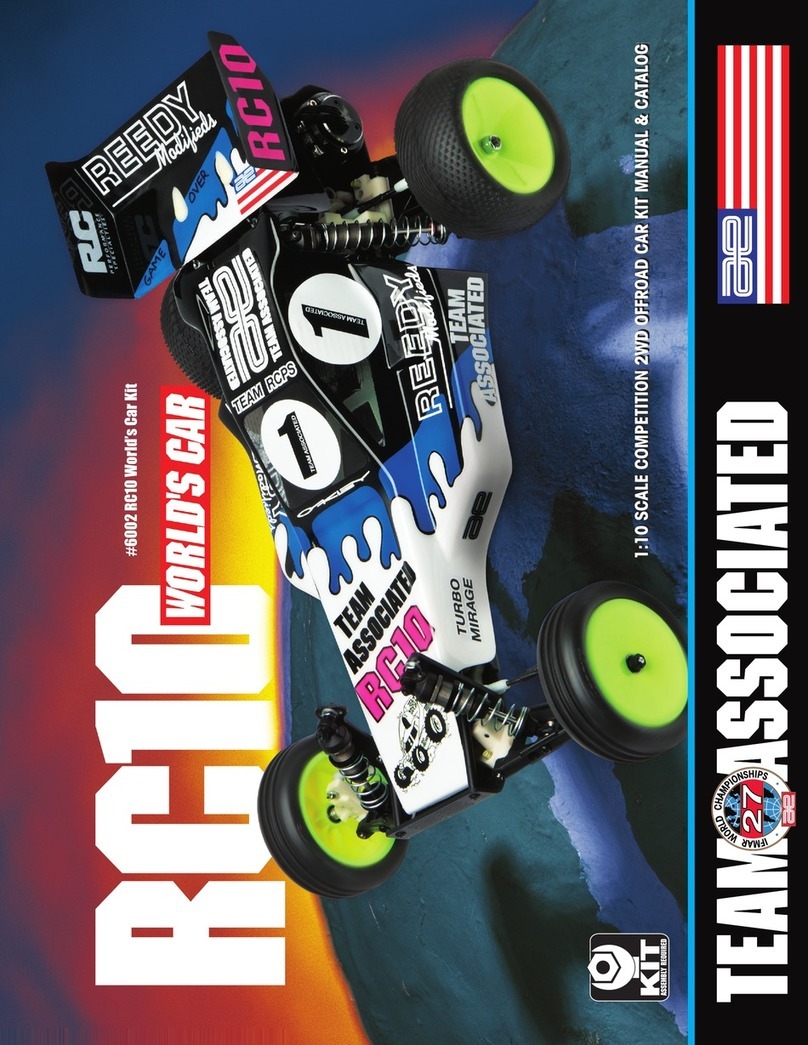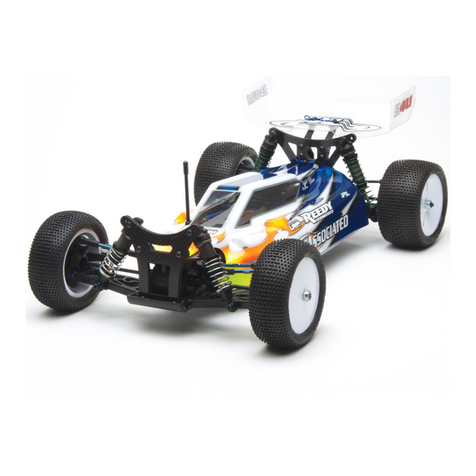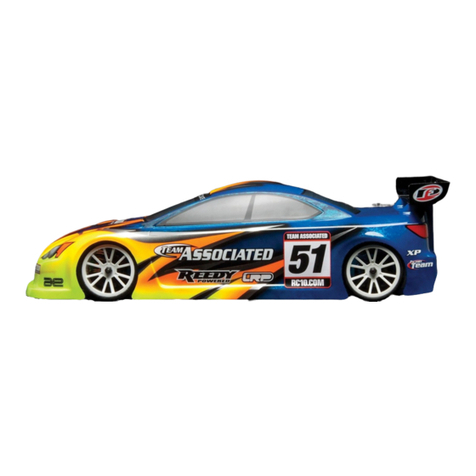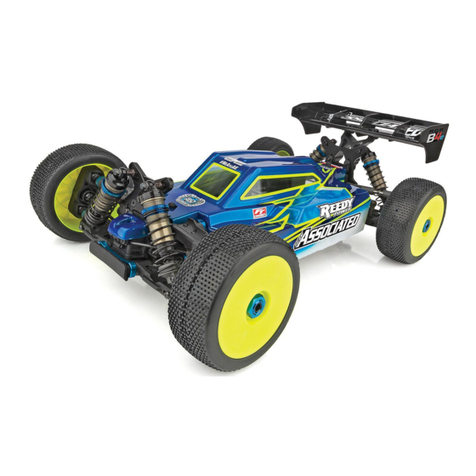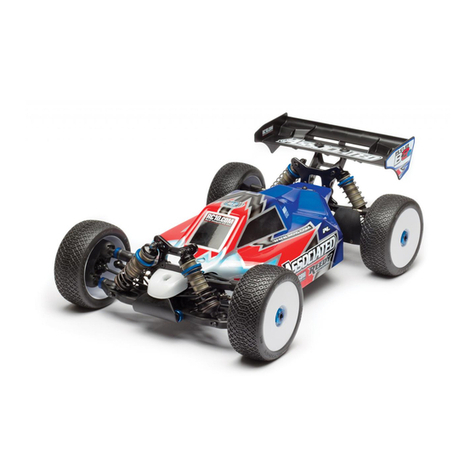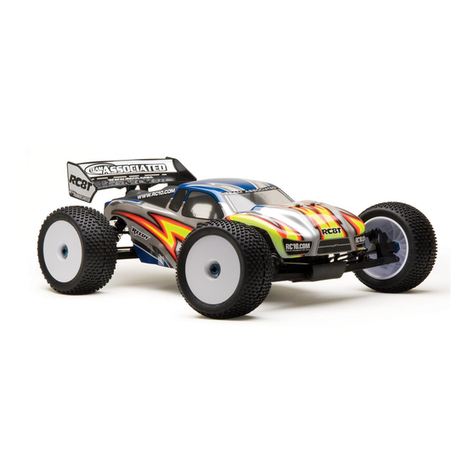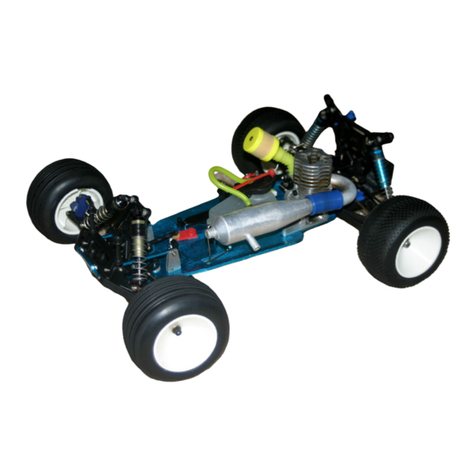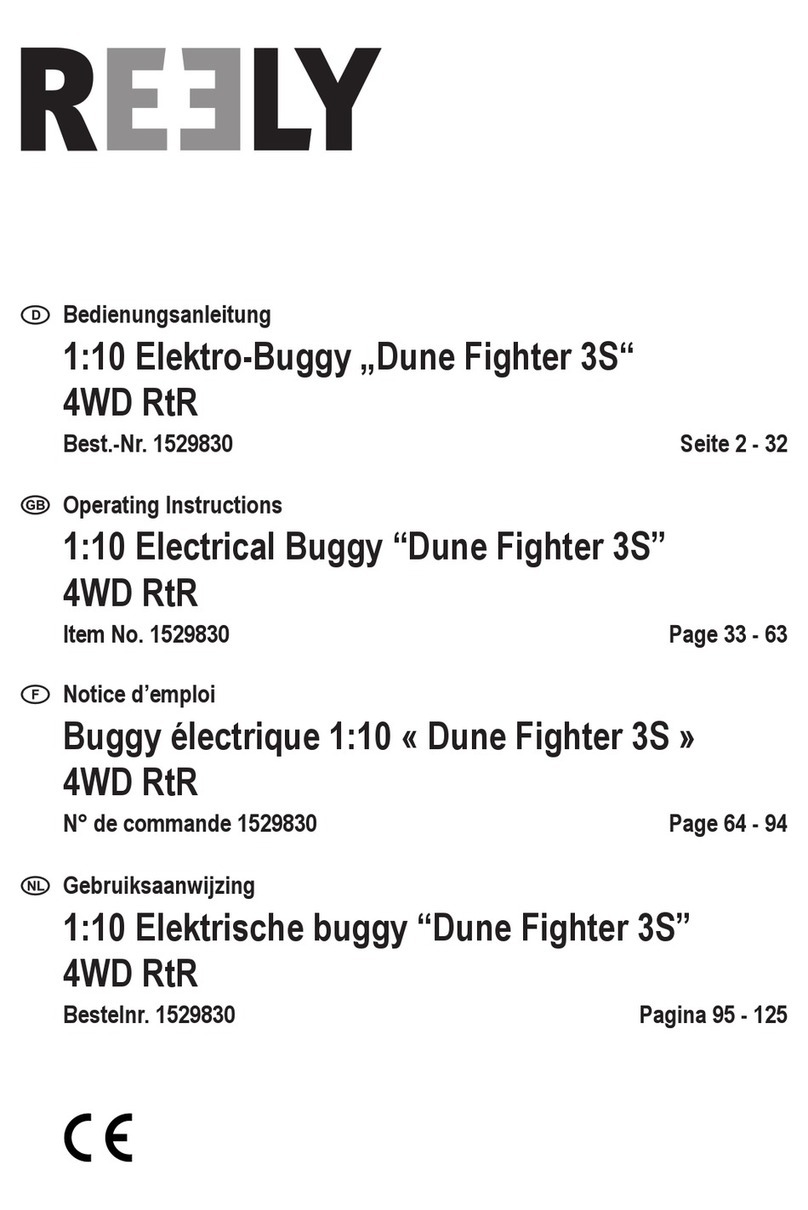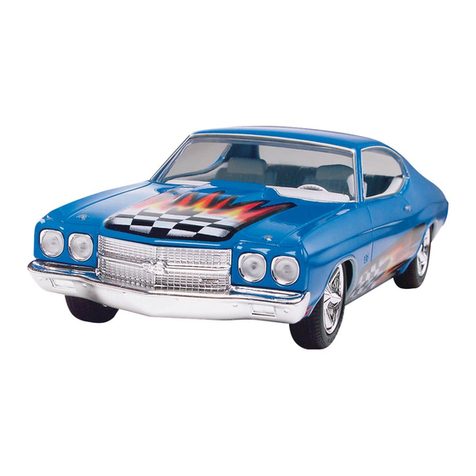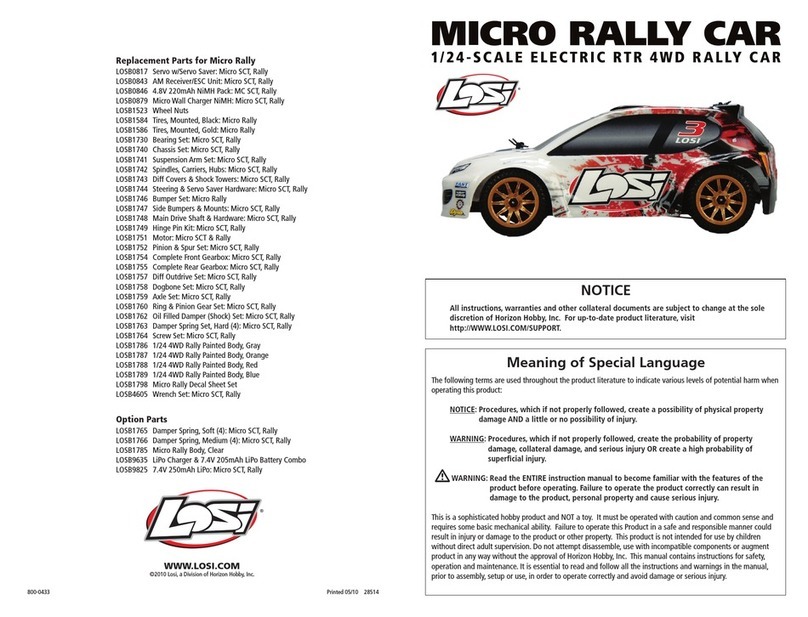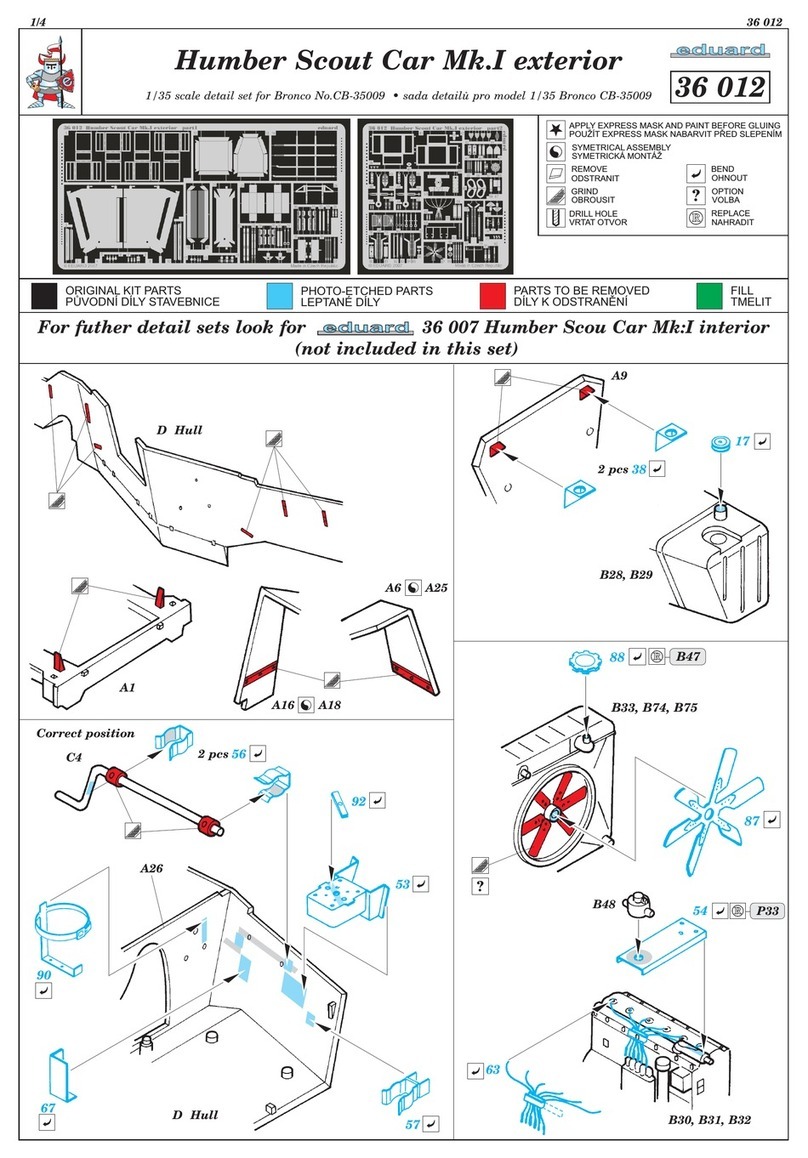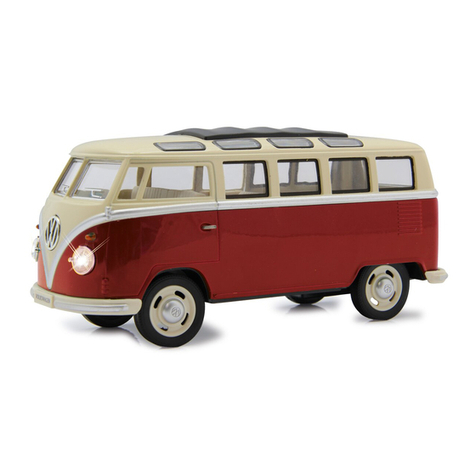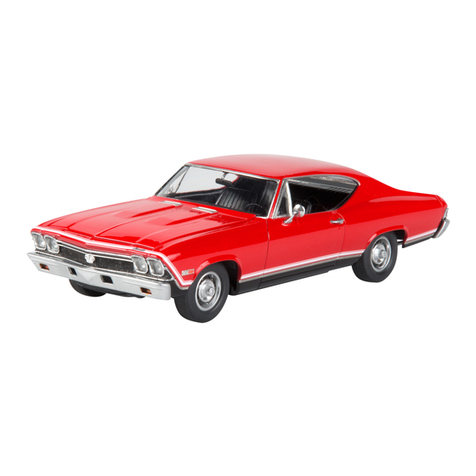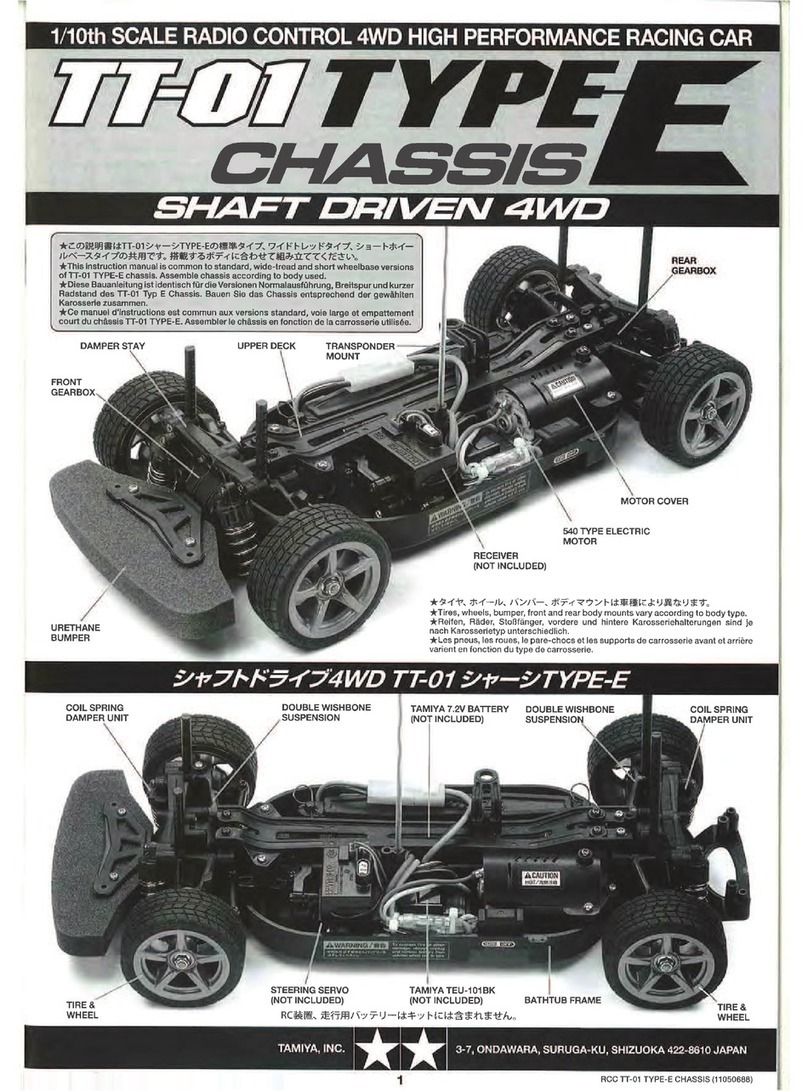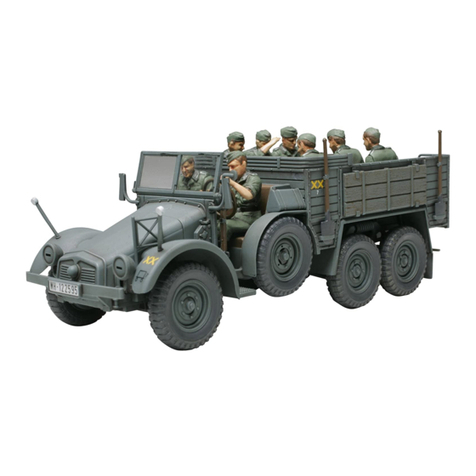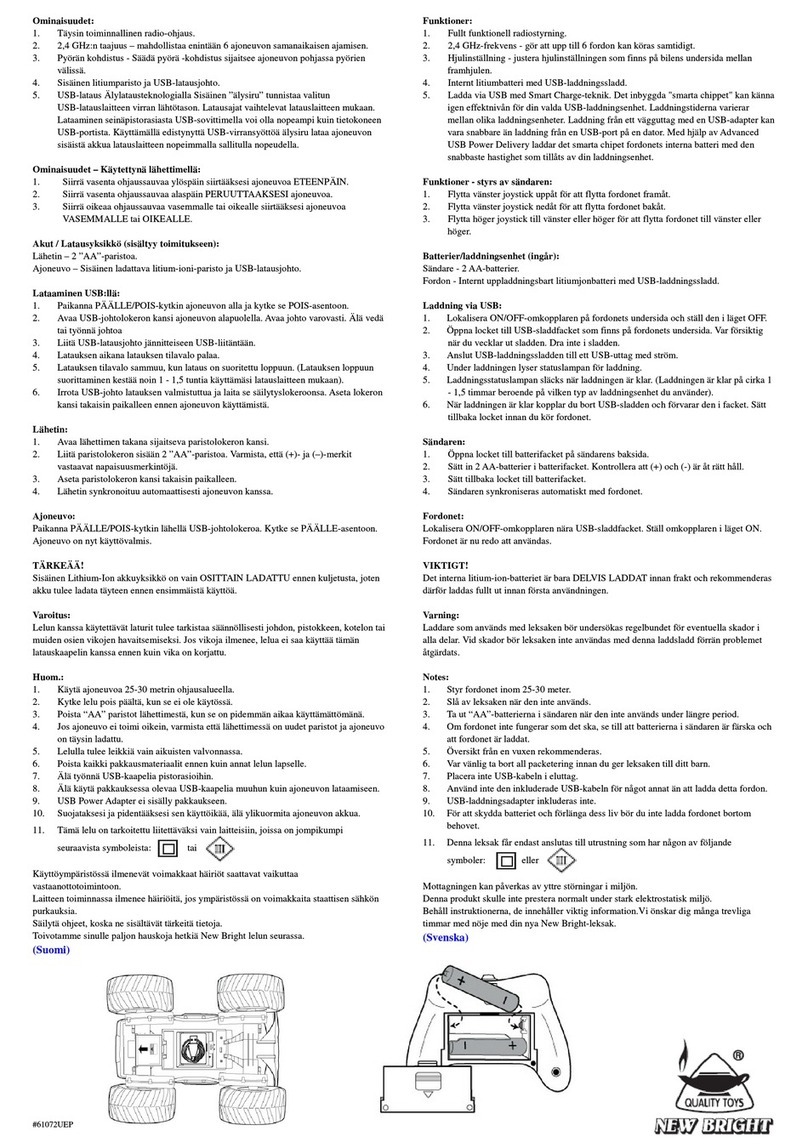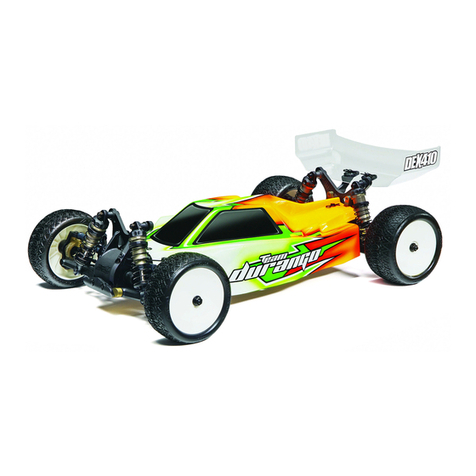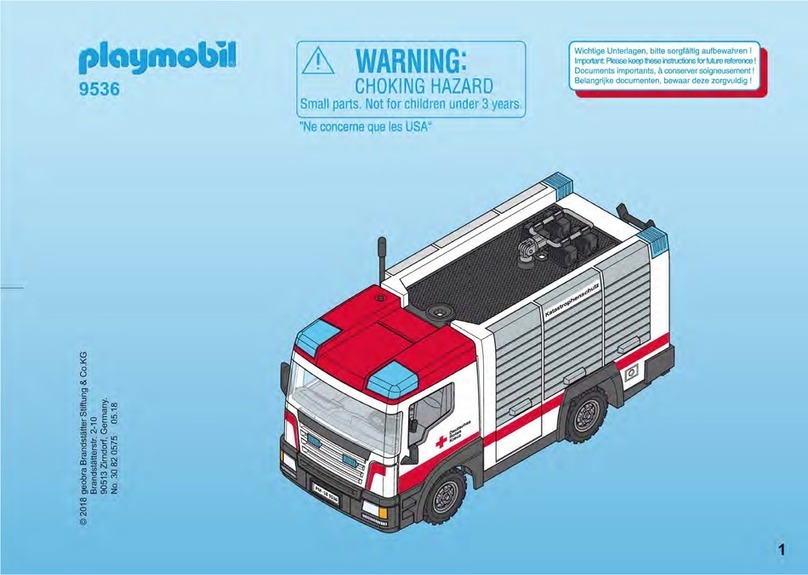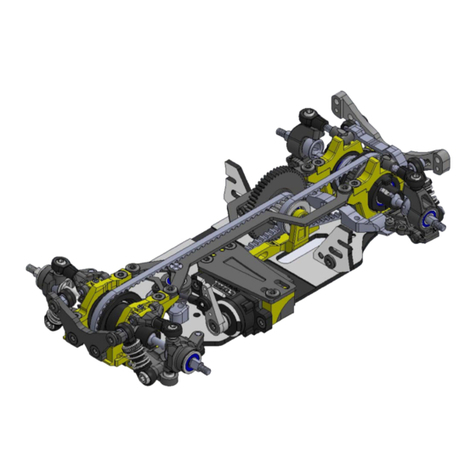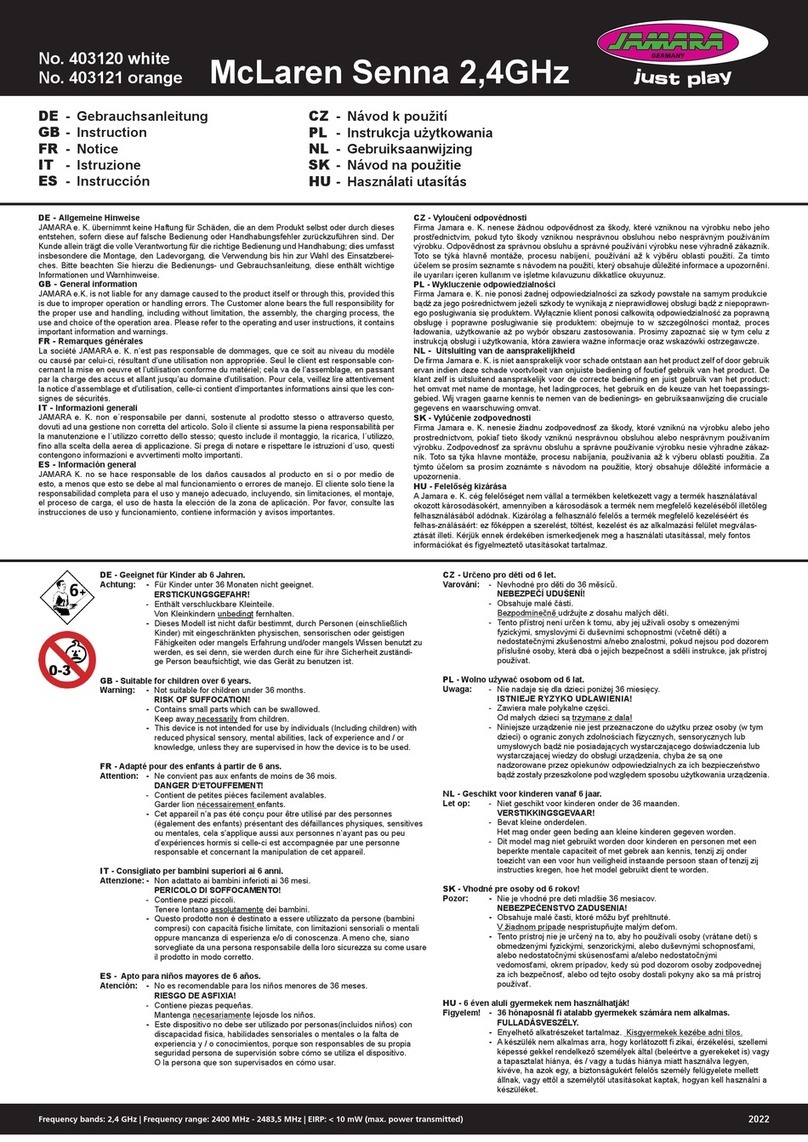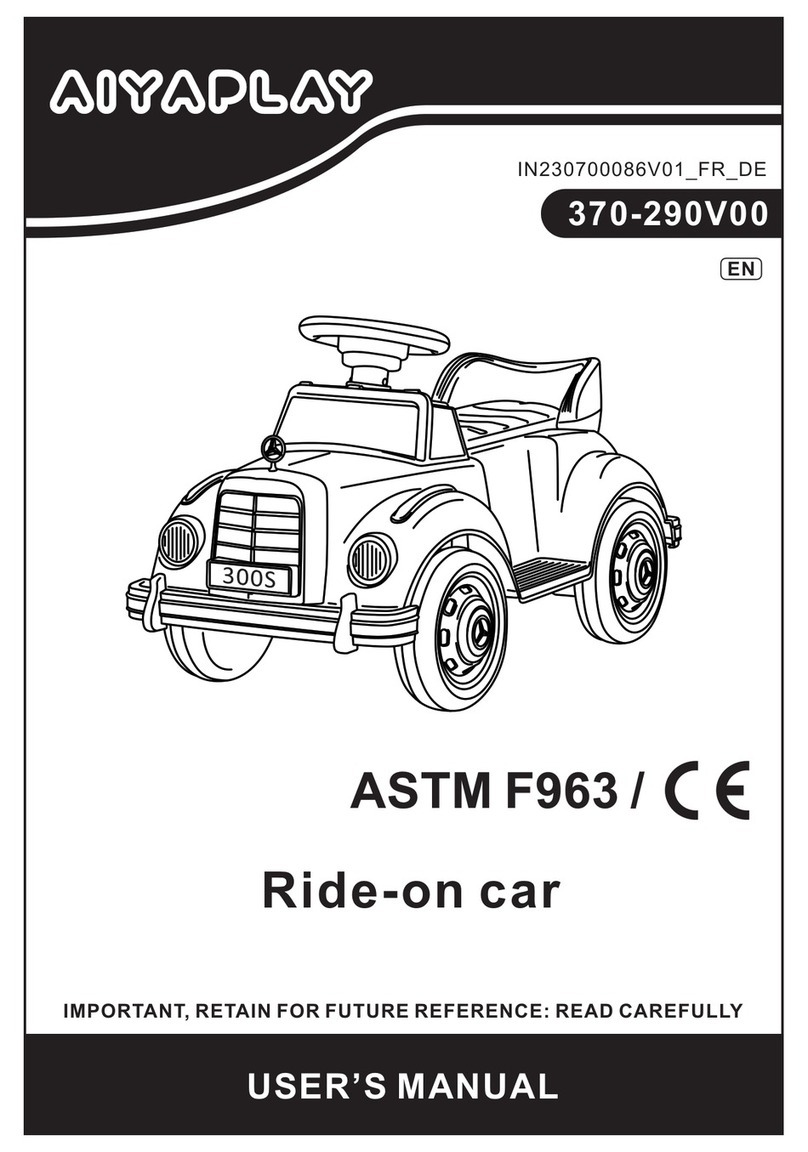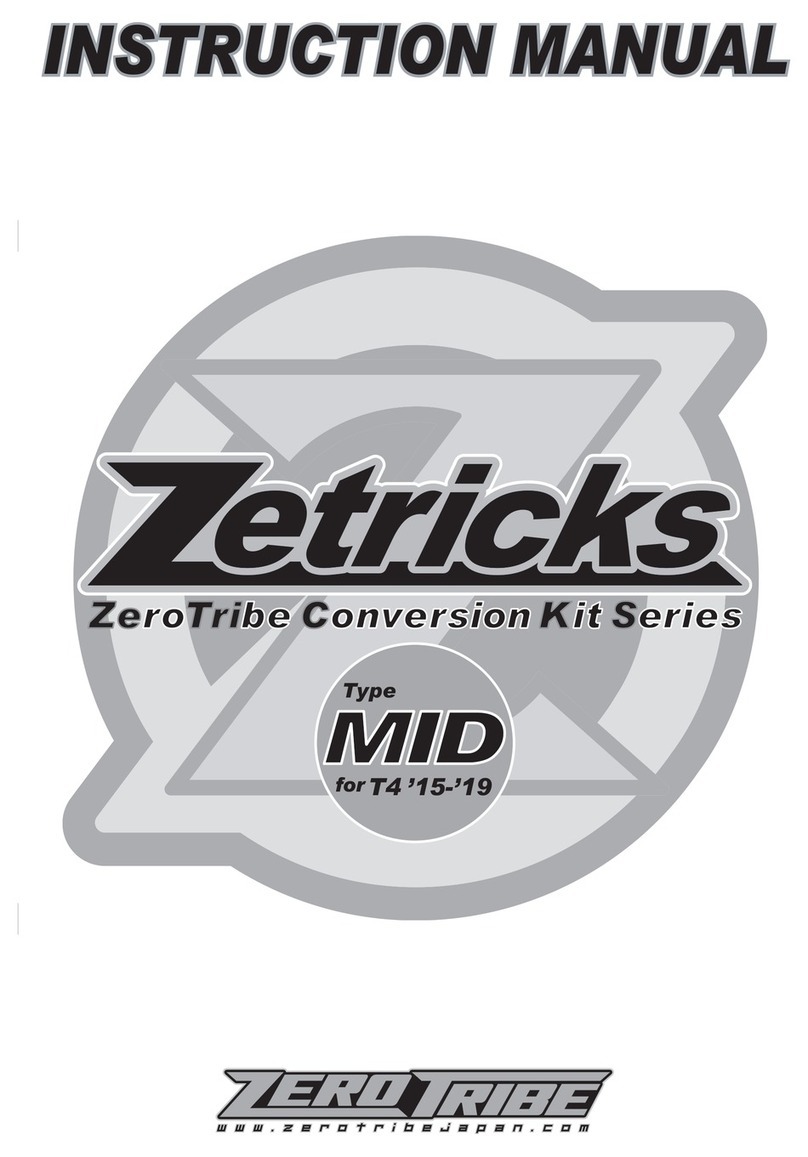AE TEAM ASSOCIATED RC10T4 TRUCK User manual

INSTRUCTIONMANUALFORTHE
TEAMASSOCIATEDRC10T4TRUCK
©2006 Associated Electrics, Inc.
INSTRUCTIONMANUALFORTHE
TEAMASSOCIATEDRC10T4TRUCK
ASSOCIATED1:10SCALEELECTRICTRUCKMANUAL
RS-1
TT

















FINAL ADJUSTMENTS
RADIO ADJUSTMENTS
Use the following steps to make the final ad-
justments on your car.
1. Turn the transmitter on.
2. Make sure the motor is disconnected.
3. Connect your battery pack and turn the
power switch on.
4. Move the steering control on the transmitter
to the right and left. Do the wheels move in the
correct direction? If not, you must reverse the
steeringservodirectiononyourtransmitter(see
radio manual.)
5.Adjust your steering trim (see radio manual)
until the #9659 steering rack is centered un-
der the top plate. Then, using the two steering
turnbuckles, adjust the front wheels so they
are pointing straight ahead.
6. Adjust the ESC (electronic speed control)
according to the speed control manufacturer’s
instructions. Some manufacturers have the
motorconnectedduringadjustmentand some
do not. Now turn the power switch off.
7. Connectthemotor.Placeyourcaron a block
orcarstand sothatallfour wheelsareelevated.
Turnthepowerswitch on again. ChecktheESC
and steering settings you have made and then
turn the power switch back off.
8. Remember this! The transmitter is always
the FIRST TO BE TURNED ON and THE
LAST TURNEDOFF.
Make these adjustments before you drive the truck
MOTOR GEARING
To get the most from your motor, proper gear-
ing is important. The gear ratios listed in the
chart are recommended starting gear ratios.
Ratios can vary from track to track, but you
should not change the pinion size more than
one tooth from the recommended ratio.
FINAL
MOTOR PINION SPUR DRIVE RATIO
24° stock (torque-based) 20 87 11.31:1
24° stock (RPM-based) 19 87 11.91:1
19 turn 19 87 11.91:1
14 turn modified motor 22 87 10.28:1
13 turn modified motor 21 87 10.77:1
12 turn modified motor 20 87 11.31:1
11 turn modified motor 19 87 11.91:1
10 turn modified motor 18 87 12.57:1
MAINTENANCE Follow these steps to keep your truck in shape for racing
CHECK FOR FIT
You should periodically check all the moving
parts: front and rear end, suspension arms,
steering blocks, steering linkage, shocks, and
so on. If any of these should get dirty or bind
then your car’s performance will suffer.
MOTOR MAINTENANCE
Between runs, inspect the brushes to ensure
theyare moving freely inthe brush holder. This
is done by carefully removing the spring and
slidingthebrush inandoutofthe holder. Ifthere
is any resistance or rough spots, remove the
brush and carefully wipe the brush clean. This
will clean off any buildup so the brush slides
smoothly in the brush holder.
Afterevery3to5runs,removethebrushes
from the holders and inspect the tips for wear
and/or burning. If there is a noticeable amount
of wear, replace the brush with a new pair. If
the tip is a burnt blue color, then the lubricant
in the brush has been burned away and new
brushes should be installed.
Aftereveryotherbatterychargeyoushould
carefully clean the motor. One recommended
method is to spray motor cleaner directly on
the brush and commutator area. Run the mo-
tor for approximately 15 seconds. Disconnect
the motor and spray it again, making sure the
runoffisclearandclean.Ifthe runoff is still dirty,
repeatthesprayingactionuntilclean.Aftercom-
pleting the cleaning, apply a small amount of
lightweight oil to each bushing or bearing for
lubrication. Be careful not to apply too much
oil, for this will pick up dirt and contaminate the
commutator and brushes.
20
ASSEMBLE BATTERY PACK
If you are not using a stick battery pack, here is
how to assemble your battery pack. Solder in-
dividual cell connections as shown.
Team racers prefer battery bars for stur-
dier connections. Insulated wire will not allow
the pack to fit in the battery slot. Solderconnectionswithbattery bars
(#651)
DIFFERENTIAL
Adjust the differential (“diff”) as noted on page
6. Adjusting the diff is not meant to be a tuning
option. If you can hear the diff making a “bark-
ing” or “chirping” sound on jump landings, ei-
ther your diff is set too loose or your slipper
clutch is set too tight. First check your slipper
setting, then re-set the diff according to the in-
structions on step C-9.
SLIPPER CLUTCH
The assembly instructions give you a base
setting for your clutch. Turn the nut on the
shaft so that the end of the top shaft is even
with the outside of the nut. Tighten the nut 3
more turns. At the track, tighten or loosen the
nut in 1/8 turn increments until you hear a
faint slipping sound for 1-2 feet on takeoffs.
Another popular way to set the clutch is
to hold both rear tires firmly in place and
apply short bursts of throttle. If the clutch is
properly set, the front tires should lift slightly
up off the surface.
Aimnegativeleadtowardthefront
CAUTION! Increasing the
pinionsizebymorethanonetooth
candamageyourmotorfromex-
cessheat.

Testingcamberwiththe
cambergauge
Raiseor lower
theballend by
addingor
subtracting
washershere
STEERING BLOCKS
The included trailing steering blocks (#9581)
should be used in most cases. The Team es-
peciallyrecommendsthetrailingblocksonhigh-
gripor “blue-groove”.
Changing to the optional inline steering
blocks (#9577) and axles (#7459) will give the
car an overall aggressive feeling. Steering en-
tering and exiting the corners is increased, but
straight line stability is reduced.
TUNING&SETUPTIPS These steps prepare your buggy for maximum performance
CASTER
Caster describes the angle of the kingpin as it
leans toward the rear of the vehicle. Positive
castermeansthe kingpin learnsrearwardatthe
top. Thesupplied25°casterblocks(#9580)are
recommendedinmostcases.Formorecorner
entry steering and less exit steering, try the
optional30° blocks (#9593).
The optional 20° blocks (#9592) will give
you more exit steering and less entry steering.
FRONT CAMBER LINKS
Changing the length of the camber link is
considered a bigger step than adjusting the
ball end height on the tower. Shortening the
camber link (or lowering the ball end) will give
the front end less roll and quicken steering
response. Lengthening the camber link (or
raising the ball end) will give the front more
roll and slower steering response.
Longer camber links are typically used
on high grip tracks and shorter links tend to
work better on medium-grip loose tracks.
Raiseorlowertheball
endbyaddingorsubtract-
ingwashers here
CAMBER
Camber describes the angle at which the tire
and wheel rides when looked at from the front.
Negative camber means that the tire leans in-
ward at the top.
Agood startingcambersettingis–1°. Use
the included #1719 camber gauge to set your
camberasshown. Positive camber, wherethe
top of the tire is leaning out, is not recom-
mended.
FRONT TOE-IN
Toe-in describes the angle of the front tires
whenviewedfromthe top. With toe-in,thefront
of the tires point inward.
Zero degree toe-in (tires pointing straight
forward) is the setting that should be used in
almost all track conditions. Occasionally you
can increase turn in by adding a little toe-out
(front of tires point slightly out). Front toe-in is
not a typical tuning adjustment used by the
Team.
FRONT RIDE HEIGHT
Ride height is the distance from the ground to
the bottom of the chassis.
The standard front ride height setting is
with the front arms level (referred to as “arms
level”). Check the ride height by lifting up the
entire car about 8-12 inches off the bench and
dropit.Afterthesuspension“settles”intoplace,
add or remove pre-load clips so that the left &
right arms appear to be flat as seen in the fol-
lowing picture.
ANTI-SQUAT
Anti-squat denotes the angle of the rear arms
relative to the ground. Zero anti-squat means
that the rear arms are flat, parallel with the
ground. The kit setting is 2°, and can be ad-
justed by installing or removing the included
REAR CAMBER LINK
Changing the length of the camber link is con-
sidered a bigger step than adjusting the ball
endheightontherear chassis brace. Shorten-
ing the camber link (or lowering the ball end)
will give the rear end less roll and the car will
tendtoaccelerateor“squareup”better.Length-
ening the camber link (or raising the ball end)
will give the rear more roll and more cornering
grip. Longer camber links are typically used on
highgriptracks,whileshorter links tend to work
betteron med-grip loose tracks.The kit setting
is the best compromise of cornering grip and
acceleration.
Uppershim (with one tab),1°
Lowershim (with two tabs),2°
shims underneath the arm mount.
Theshimwith2tabsisfor 2° and the shim
with 1 tab is for 1°. You can use any combina-
tion of shims to get 0, 1, 2, or 3° anti-squat.
Adding anti-squat tends to make the car “ro-
tate” more in corners, but doesn’t handle as
well through the bumps.
REAR CAMBER
Camber describes the angle at which the tire
and wheel rides when looked at from the back.
Negative camber means that the tire leans in-
ward at the top.
Agood startingcambersettingis–1°. Use
the included #1719 camber gauge to set your
camber(shownabove). Addingasmallamount
of positive camber, where the top of the tire is
leaning out, will tend to improve straight-line
acceleration on loose tracks.
21
Frontarmsshouldbeina
straightlinewhenrideheight
issetas“armslevel”

ANTI-ROLL BAR
The optional #9635 B4/T4 rear anti-roll bar kit
(also called the “swaybar”) allows you to add
roll resistance to the rear end with minimal ef-
fect on handling over bumps and jumps. It is
an especially helpful tuning item on high-grip
tracks (try the gold bar). The silver and black
anti-rollbars are typically usedon medium-grip
loosetracks.
REAR RIDE HEIGHT
Ride height is the distance from the ground to
the bottom of the chassis.
Therearrideheightsettingyoushoulduse
most often is with the outdrive, driveshaft, and
axles all on the same imaginary horizontal line
(referred to as “bones level”). Check the ride
height by lifting up the entire car about 8-12
inches off the bench and dropping it. After the
suspension“settles”intoplace,addorremove
pre-loadclipssothat the left &rightdriveshafts
appear to be flat as seen in the following pic-
ture.
BATTERY PLACEMENT
This is one of the best adjustments on the car,
and it can have the biggest effect on handling.
Most of the time, moving the battery pack back
willyieldmorereartractionanddecreasesteer-
ing. Conversely, moving the battery pack for-
ward will yield less rear traction and increase
steering. But in some cases on extremely high
grip or extremely low grip tracks, moving the
pack forward will make the car feel more bal-
anced and actually improve rear grip.
SETUP SHEETS
Thebest way to getyour car handling rightis to
go to our website, www.rc10.com,and click on
the links for setup sheets. Our Team Drivers
help develop these setups at National events.
Also,mostdrivershavea“base”setupthat
they use as a starting point for every event. Try
running some of these base setups or look for
TEAM ASSOCIATED ONLINE
Getonline help, tips, andnew product informa-
tionforyour kit throughTeamAssociated’sweb
site,www.TeamAssociated.com.
Kit Tips & Help. Have questions? Look here
first!
Parts Catalogs. Your printed catalog is prob-
ably already out of date! Find the most up-to-
date listing of parts for your kit.
22
Contact Associated.Ourexpertstaffanswers
your toughest questions about Associated,
Reedy,and LRP products.
Racer’s Spotlight. Racers proudly show off
their favorite kits. Get your painting ideas here!
Setup Sheets. Where racers find blank and
standard setups for different track conditions.
What are the winning racers using?
New Products. Learn of new kits and parts
before they are announced anywhere else.
TeamAssociatedInsider’s Newsletter.Sign
up for it if you want the latest Team Associated
news delivered right to your e-mail box.
Hobby Shop and Track Directory. Locate
shops carrying spare parts and find tracks
where you may race your car.
trackconditionsandtires that are similartoyour
local track and mimic that setup.
Remember, each adjustment has a pur-
pose,so copy everything fromthe setup sheet
and then make adjustments based on the rec-
ommendations in here.
WHEELBASE ADJUSTMENT
You have three options for rear hub spacing,
Forward, Middle, & Back. The kit setting pro-
vides the most rear traction, and will be used
mostoften.For improved handlinginbumpsor
rhythm sections, try moving the hubs to the
Middle or Back position. This can also make
the car handle better in 180° turns. Spacerstotherearwillplacehubs
forward,shorteningthe wheelbase
Spacersto thefrontwill place
batteriesto the rear Spacers totherear willplace
batteriesto the front
FRONT REAR FRONT REAR
Dogbonesshouldbeina
straightlinewhenrideheight
issetas“dogboneslevel”
Other manuals for TEAM ASSOCIATED RC10T4 TRUCK
1
Table of contents
Other AE Motorized Toy Car manuals
